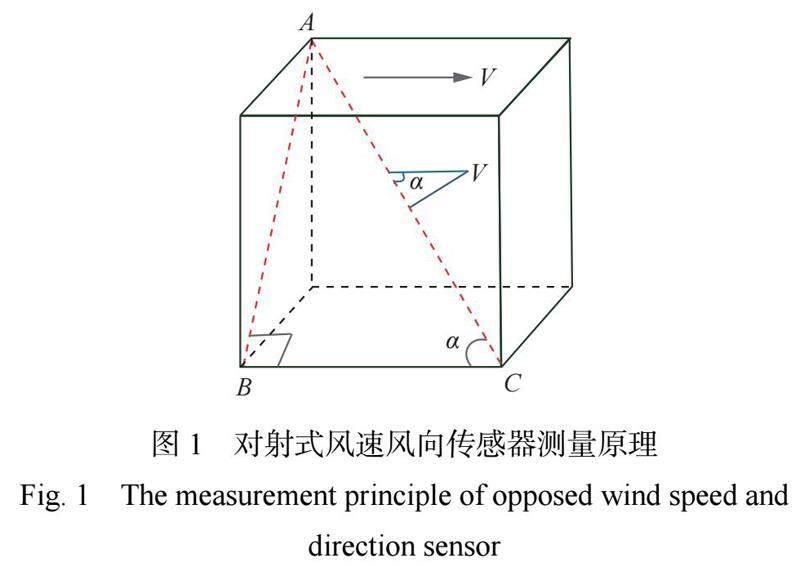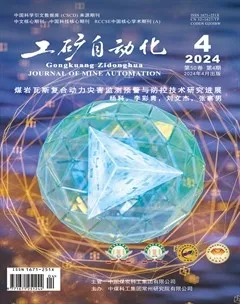矿用对射式风速风向传感器设计
2024-05-27安赛赵忠辉张浪李伟彭然
安赛 赵忠辉 张浪 李伟 彭然



文章编号:1671?251X(2024)04?0050?05 DOI:10.13272/j.issn.1671-251x.2024010055
摘要:针对目前风速传感器启动风速高、设计方案复杂、无法准确测量巷道整个断面平均风速的问题,基于超声波对射式测风原理,设计了以 STM32为核心的矿用对射式风速风向传感器,介绍了传感器总体结构、收发电路设计、滤波算法及软件流程。该传感器改变了以点带面的测风方式,通过大距离(5~12 m)超声测风技术测量巷道中线风速,以该风速代表整个巷道的平均风速,提高了巷道风速测量的准确性和实时性。依据设计方案研发了测试样机,在环形风洞中的测试结果表明,该传感器测量值与风速标准值在0.1~15 m/s 内具有较好的一致性,测量误差小于0.1 m/s,能够满足智能化矿井对巷道风速测量精度的要求。
关键词:智能化通风;风速风向传感器;巷道断面风速;超声波测风;对射式测风;巷道中线风速中图分类号:TD723 文献标志码:A
Design of mine opposed wind speed and direction sensor
AN Sai1,2,3,4, ZHAO Zhonghui1,2,3,4, ZHANG Lang1,2,3,4, LI Wei1,2,3,4, PENG Ran1,2,3,4
(1. China Coal Research Institute, Beijing 100013, China;2. CCRI Tong'an(Beijing) Intelligent Control TechnologyCo., Ltd., Beijing 100013, China;3. Beijing Engineering and Research Center of Mine Safe, Beijing 100013, China;4. State Key Laboratory of Intelligent Coal Mining and Strate Control, Beijing 100013, China)
Abstract: In response to the current problems of high startup wind speed, complex design schemes, and inability to accurately measure the average wind speed of the entire section of the roadway using wind speed sensors, based on the principle of ultrasonic opposed wind measurement, a mine opposed wind speed and direction sensor with STM32 as the core is designed. The overall structure of the sensor, the design of the transmitting and receiving circuit, the filtering algorithm, and the software process are introduced. This sensor has changed the wind measurement method from point to surface, using a single ARM core and measuring the wind speed at the centerline of the roadway through long-distance (5-12 m) ultrasonic wind measurement technology. This wind speed represents the average wind speed of the entire roadway. It greatly improves the accuracy and real-time performance of roadway wind speed measurement. A test prototype is developed based on the design scheme, and the test results in a circular wind tunnel show that the measured values of the sensor has good consistency with the standard wind speed values in the range of 0.1-15 m/s, with a measurement error of less than 0.1 m/s. It can meet the precision requirements of intelligent mines for roadway wind speed measurement.
Key words: intelligent ventilation; wind speed and direction sensor; wind speed at the cross-section of the roadway; ultrasonic wind measurement; opposed wind measurement; wind speed at the centerline of the roadway
0引言
煤礦井下巷道风速的精确测量是实现煤矿通风智能化的基础[1-5]。目前井下巷道风速测量方法主要有机械式风表、压差式风速传感器、超声波涡街式风速传感器,其测量范围大多为0.3~15 m/s,误差为0.2 m/s,启动风速为0.3 m/s 以上。《煤矿安全规程》要求掘进中的岩巷和其他通风人行巷道的最低允许风速为0.15 m/s;《国家能源集团煤矿智能化建设指南(2022版)》要求在测风站布置风速传感器,量程为0.1~15 m/s,精度为0.1 m/s,分辨率为0.01 m/s。现有的风速传感器无法满足测量要求[6-8]。
超声波风速测量仪可适应恶劣环境,具有较高的精度和较宽的测量范围,应用超声波时差法的点式风速传感器在矿井也有应用,但其测量的有限区域较小,不能反映巷道断面的平均风速[9-11],且现有超声波风速传感器采用 ARM+FPGA 或 ARM+ CPLD [12-14]进行系统设计,设计复杂且功耗较高。针对目前传感器启动风速高、设计方案复杂、无法准确测量巷道整个断面平均风速的问题,本文设计了一种高精度、低成本、线式对射风速风向传感器。该传感器改变了以点带面的测风方式,采用单片 ARM 核心,通过大距离(5~12 m)超声测风技术测量巷道中线风速,以该风速代表整个巷道的平均风速,极大地提高了巷道风速测量的准确性和实时性。
1对射式风速测量原理
对射式风速风向传感器通过测量超声波顺逆流传播时间计算风速[15-18],测量原理如图1所示。其中点 A,C 分别为换能器1、换能器2的安装地点,通常位于巷道两帮,距离为5~12 m;平均風速 V 平行于巷道,为待计算量;风速与线段 AC 的夹角为α, 且 cos α=LBC/LAC,LAC,LBC 分别为线段 AC,BC 的长度。
工作时,换能器1与换能器2互为收发。换能器1发送、换能器2接收时,顺风风流中超声波的传播时间为
式中 c 为超声波在巷道空气中的传播速度, c =331:34+0:607t ,t 为当前空气温度。
换能器2发送、换能器1接收时,逆风风流中超声波的传播时间为
用式(1)减式(2)并进行变换,得
用式(1)加式(2)并进行变换,得
由式(3)可知,通过测量 LBC,LAC,TAC,TCA 即可计算出平均风速V,且与 c 无关。由式(4)可知,可计算当前温度及超声波传输速度,用于反向验证测量时间是否正确。
2对射式风速风向传感器设计
2.1总体设计
对射式风速风向传感器采用 STM32高性能单片机为核心,主要由超声波换能器、发射电路、通道切换电路、接收电路、核心电路、数据存储模块、显示交互模块等组成,如图2所示。
换能器1发送、换能器2接收时,通过发射接收切换电路将发射波形加载到换能器1上,同时计数单元开始计时。换能器2接收波形后,通过发射接收切换电路进入接收电路,计数单元停止计时,同时 STM32内部模数(AD)转换对接收波形进行实时采集,综合处理后得到一组时间信息。换能器2发送、换能器1接收时,同理可得另一组时间信息,通过式(3)即可计算出平均风速。
2.2发射电路
换能器的安装距离一般为8 m左右,为了保证接收换能器能够采集到高信噪比的波形,需发射端有较高的发射能量,但过高的电压可能不满足井下本安电路的设计要求。超声波发射及通道选择电路如图3所示。发射端采用双向4脉冲发射波形设计,使用变比为15∶200的脉冲变压器将10 V 电压变换为200~300 V、频率为40 kHz 的激励信号。采用导通电压为0.7 V 的二极管 D3和 D4将发射与接收过程隔离开,采用固态继电器组合实现发射状态和接收状态的切换。
2.3接收电路
对射换能器安装距离较远,接收到的信号微弱,线缆容易受井下电磁环境的影响。因此,设计了3级放大电路对接收信号进行处理。超声波接收及动态放大电路如图4所示。 PGA281(U20)构成第1级差分放大电路,实现0.125~176倍信号放大;第2级、第3级为多路负反馈二阶有源带通滤波器,其中心频率为40 kHz,品质因数为12,带宽为10 kHz,放大倍数为50。经3级放大电路后,将接收的小信号调理成直流偏置为1.65 V 的40 kHz类正弦波,一路通过比较器进入 STM32主控芯片的计数单元,另一路进入 STM32内部 AD 进行高速数据采集。
2.4数据处理
设定2个换能器的安装距离为10 m,则完成2次对射测量最少需60 ms。为了保证数据处理时间,设置1组测量时间为100 ms 。则1 s 内可进行10组测量。为了剔除掉原始数据中的随机噪声及干扰,将1 s 内的10组数据去掉2个最大值和2个最小值,其余数据取均值作为当前的实时风速。为了进一步提高输出风速的稳定性,抑制随机误差的影响,采用滑动平均法[19-21]处理风速数据,考虑数据的实时性,一般平滑周期设为5。
2.5软件设计
系统软件主要实现参数设置、超声波发射与接收信号测量、风速计算、数据显示等功能,软件流程如图5所示。传感器上电后,STM32进行系统、内部定时器、AD 等外设初始化,并进行系统自检。若自检不通过,则通过屏幕或输出端口输出故障码;若自检通过,则自动获取2个换能器的直线距离。通过 STM32内部 IO 端口控制发射与接收通道,同时开启计时和 AD 转换,1 s 内完成10次测量,通过滑动平均法对数据进行处理,最终通过屏幕显示风速值,并将数据上传。
3环形风洞测试
为了验证矿用对射式风速风向传感器的测试精度,搭建了满足 QXT 323—2016《气象低速风洞技术条件》、JJF 1934—2021《超声波风向风速测量仪器校 准规范》、MT 448—2008《矿用风速传感器》标准的环形风洞,如图6所示。风速测量范围为0~30 m/s,
测试段尺寸为1100 mm×1100 mm。
风洞采用开环控制方式,依次调节不同风速测试点,待风速值稳定后,记录测量值与标准值,同时对传感器进行线性拟合与校准。线性校准后的传感器性能测试结果见表1。
由表1可知,风速标准值与校准后风速测量值在0.1~15 m/s 内具有较好的一致性。标准风速为4.95 m/s 和25.10 m/s 时误差均超过0.1 m/s。这是由于风洞低速(<4.9 m/s)测量使用的是热式风速传感器,高速(>4.9 m/s)测量使用的是皮托管,经过测试,在该高低速转换点有0.1 m/s 的转换误差,减掉转换误差后,测量误差为0.02 m/s;25.10 m/s 在传感器量程外,此时测试风洞噪声较大,震动引起的测量误差较大。测试结果表明,对射式风速风向传感器满足风速在0.1~15 m/s 内误差小于0.1 m/s 的设计要求。
4结语
基于超声波对射式测风原理,设计了以 STM32为核心的矿用对射式风速风向传感器。介绍了传感器总体结构、收发电路设计、滤波算法及软件流程。依据设计方案研发了测试样机。在环形风洞中的测试结果表明,该传感器风速测量值与风速标准值在0.1~15 m/s 内具有较好的一致性,能够满足智能化矿井对巷道风速测量精度的要求。
参考文献(References):
[1]周福宝,辛海会,魏连江,等.矿井智能通风理论与技术研究进展[J].煤炭科学技术,2023,51(1):313-328.
ZHOU Fubao,XIN Haihui,WEI Lianjiang, et al. Research progress of mine intelligent ventilation theory and technology[J]. Coal Science and Technology,2023,51(1):313-328.
[2]张庆华.我国煤矿通风技术与装备发展现状及展望[J].煤炭科学技术,2016,44(6):146-151.
ZHANG Qinghua. Development and prospect of mine ventilation technology and equipment[J]. Coal Science and Technology,2016,44(6):146-151.
[3]张富凯,孙一冉,孙君顶,等.矿井智能通风系统关键技术研究[J].煤矿安全,2023,54(2):46-53.
ZHANG Fukai, SUN Yiran, SUN Junding, et al. Research on key technologies of mine intelligent ventilation system[J]. Safety in Coal Mines,2023,54(2):46-53.
[4]程晓之,王凯,郝海清,等.矿井局部通风智能调控系统及关键技术研究[J].工矿自动化,2021,47(9):18-24.
CHENG Xiaozhi,WANG Kai,HAO Haiqing,et al. Research on intelligent regulation and control system and key technology of mine local ventilation[J]. Industry and Mine Automation,2021,47(9):18-24.
[5]刘剑.矿井智能通风关键科学技术问题综述[J].煤矿安全,2020,51(10):108-111,117.
LIU Jian. Overview on key scientific and technical issues of mine intelligent ventilation[J]. Safety in Coal Mines,2020,51(10):108-111,117.
[6]邵良杉,于保才,陳晓永.矿井智能通风关键技术[J].煤矿安全,2020,51(11):121-124.
SHAO Liangshan,YU Baocai,CHEN Xiaoyong. Key technology of mine intelligent ventilation[J]. Safety in Coal Mines,2020,51(11):121-124.
[7]徐新坤.煤矿用机械叶片式风速表测量准确度的影响因素[J].煤炭与化工,2016,39(5):136-137,140.
XU Xinkun. Influencing factor of the accuracy of mine mechanic blade type anemometer [J]. Coal and Chemical Industry,2016,39(5):136-137,140.
[8]蒋泽,郝叶军,刘炎.一种矿用皮托管式风速传感器设计[J].工矿自动化,2012,38(11):61-63.
JIANG Ze,HAO Yejun,LIU Yan. Design of a mine- used air speed sensor based on pitot tube[J]. Industry and Mine Automation,2012,38(11):61-63.
[9]宋涛,王建文,吴奉亮,等.基于超声波全断面测风的矿井风网实时解算方法[J].工矿自动化,2022,48(4):114-120,141.
SONG Tao,WANG Jianwen,WU Fengliang,et al. Real-time calculation method of mine ventilation network based on ultrasonic full-section wind measurement [J]. Journal of Mine Automation,2022,48(4):114-120,141.
[10]卢新明,尹红.矿井通风智能化理论与技术[J].煤炭学报,2020,45(6):2236-2247.
LU Xinming,YIN Hong. The intelligent theory and technology of mine ventilation[J]. Journal of China Coal Society,2020,45(6):2236-2247.
[11]游青山.一种矿用超声波风速传感器的设计[J].煤矿安全,2017,48(1):88-91.
YOU Qingshan. Design for an mine-used ultrasonic air velocity sensor [J]. Safety in Coal Mines,2017,48(1):88-91.
[12]黄吉葵.高精度超声波风速风向仪测量系统设计与实现[D].成都:电子科技大学,2019.
HUANG Jikui. Design and implementation of high precision ultrasonic anemometer measuring system[D]. Chengdu: University of Electronic Science and Technology of China,2019.
[13]刘华欣.基于超声波传感器的风速风向测量研究[J].仪表技术与传感器,2018(12):101-104,110.
LIU Huaxin. Research on wind speed and direction measurement based on ultrasonic sensor [J]. Instrument Technique and Sensor,2018(12):101-104,110.
[14]褚卫华,顾正华.风洞超声波风速风向三维测量装置设计与实现[J].自动化与仪器仪表,2023(1):36-41,47.
CHU Weihua,GU Zhenghua. Development of ultrasonic three-dimensional wind speed and direction measuring device for wind tunnel[J]. Automation & Instrumentation,2023(1):36-41,47.
[15]楚航,赵佳佳.基于 STM32F4的超声波测风速风向仪的设计[J].自动化技术与应用,2017,36(7):133-136. CHU Hang, ZHAO Jiajia. Design of ultrasonic measuring wind speed and direction instrument based on STM32F4[J]. Techniques of Automation and Applications,2017,36(7):133-136.
[16]罗永豪.巷道断面风速分布与煤矿通风系统实时诊断理论研究[D].太原:太原理工大学,2015.
LUO Yonghao. Theoretical study on wind velocity distribution in the section of roadway and real time diagnostics on mine ventilation systems[D]. Taiyuan: Taiyuan University of Technology,2015.
[17]冉霞,游青山.基于時差法的矿用超声波风速传感器[J].煤矿安全,2015,46(7):116-119.
RAN Xia,YOU Qingshan. Mine-used ultrasonic air velocity sensor based on time difference method[J]. Safety in Coal Mines,2015,46(7):116-119.
[18]李秉芮,刘娜,井上雅弘.高精度矿用超声波风速测量仪设计[J].工矿自动化,2022,48(2):119-124.
LI Bingrui,LIU Na,MASAHIRO Inoue. Design of high precision mine ultrasonic anemometer [J]. Industry and Mine Automation,2022,48(2):119-124.
[19]丁向辉,李平.基于 FPGA 和 DSP 的超声波风向风速测量系统[J].应用声学,2011,30(1):46-52.
DING Xianghui,LI Ping. An ultrasonic anemometer based on DSP and FPGA[J]. Applied Acoustics,2011,30(1):46-52.
[20] SHAN Zebiao,XIE Xiaoran,LIU Xiaosong. Wind speed and direction measurement based on three mutually transmitting ultrasonic sensors [J]. IEEE Geoscience and Remote Sensing Letters,2023,20:1-5.
[21] ZHAO Chen,CHEN Zezong,LI Jian,et al. Wind direction estimation using small-aperture HF radar based on a circular array[J]. IEEE Transactions on Geoscience and Remote Sensing,2020,58(4):2745-2754.
